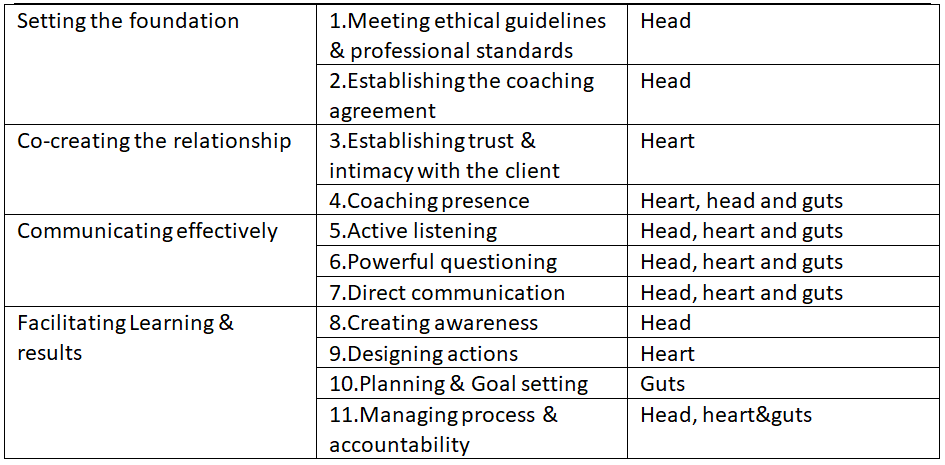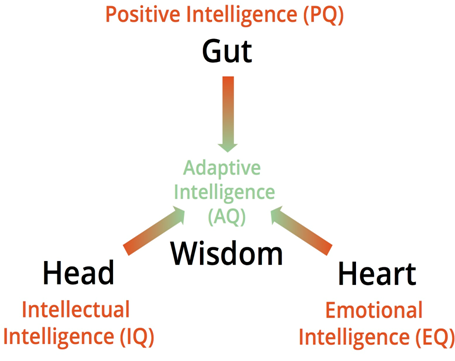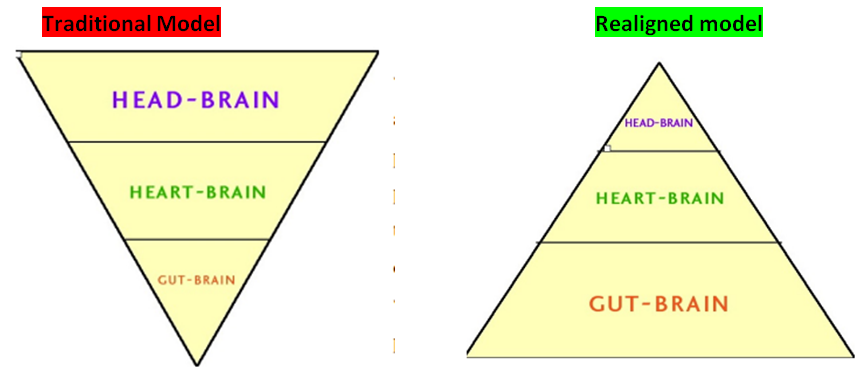
Research Paper By Ann Brown
(Life & Executive Coach, NEW ZEALAND)
The aim of the research paper is to investigate head, heart and guts, our different intelligences and demonstrate how it is used while coaching.
I rely far more on gut instinct than researching huge amounts of statistics. Richard Branson
What– multiple intelligences and coaching
Having experienced a few approaches of coaching the one that has stood out for my clients based on their feedback in terms of sustained outcomes is where head, heart and guts aligned to explore deeper. This uncovered hidden gems to enable the client to look ahead in a practical and passionate manner engaging multiple intelligences to create a ripple effect to move forward. I see parallels to the ICF coaching methodology which also requires that multiple intelligences are used in the coaching process.
Why– differentiator in the coaching evolution
As you look towards the future, the world of executive coaching may take on a new shape. There may be more automation or a stronger focus on mental status or the psychology aspect of your career. As the executive coaching industry continues to grow, so does the number of ways in which this niche is going to change in the not-so-distant future. To stay nimble in this dynamic profession, we will need to weave a strong integrated fabric by using the 3 multiple intelligences ourselves and awaken this in our clients to support achieve balance and move ahead. Artificial intelligence and robotics can already replicate the brain intelligence and can capture patterns, data and provide solutions, however the uniqueness of human interaction (warmth, empathy, courage) may yet be a little while away.
How– Coaching competencies and multiple brain intelligences
As a coach, in my view, I would apply ICF Core Competencies focussing on the client using the 3 intelligences as follows:

While working through exploration with the client, one way of reframing and creating new perspective is to ask:
During coaching, trust is formed at the outset. However, there are times we may need to generate discomfort (using guts) to create different thinking in a supportive and respectful manner by being courageous and encouraging our clients to be brave and rewire by
dancing in the moment with them to achieve progress towards what they want.
Depending on your personality as a coach you will tend to naturally draw on different intelligences more. When listening with an open mind in a non-judgemental way we will find that our clients will also draw on different intelligences based on their own personality. When we listen with our mind, heart and have the guts to connect with our client’s neurons we will achieve a connection that can be a break through. In my peer coaching sessions, I have found I must practice listening with my heart more and that awareness makes me vulnerable but brave enough to apply these learnings as a coach myself.
Leadership Coaching
Suzanne Henwood, Associate Professor in Auckland, New Zealand refers to mBIT(Multiple Brain Integration Techniques) in 3 Brains of Leadership, Harnessing the Leader Within recognising the changing needs for leaders. She says “we require wise leaders who are integrated across their head, heart and gut brains. Leaders who by aligning their conscious and unconscious intuitive abilities, can harness the innate wisdom of their head, heart and gut intelligences for powerful and generative decision-making. Truly generative and adaptive leadership today requires whole new levels of self-awareness and self-facilitation for integrating head-based intellect with heart-based values and gut-based instincts.”
Change being the only constant in a world that is evolving very fast (including the coaching profession) we will find the need to support our clients navigate change positively by adapting so they are balanced and productive with less stress while understanding this journey ourselves base on digital/ AI/ and other disruptive technologies as a coach. On the other hand, we can be an early adopter and lead the way in engaging with the changes for the benefit of our clients and the coaching community (e.g. new technology, regulations, oversight)
Wisdom is seen when all these 3 intelligences work in unison to create forward movement.

Figure 1
Referring to “Accessing the Wisdom of Your Body: Balancing the Three Brains” by Mark Chandlee Taylor, we recognise that traditional Western education values the head brain more than the heart brain or the gut brain. Eastern practices like Yoga, Tai Chi, Buddhist religion all recognise multiple intelligences. Mark is a researcher and teacher of developmental movement awareness and embodied anatomy.
He compares the traditional model of thinking to the realigned model and refers to the wide and stable base of the gut-brain that supports the loving cardiac brain, which in turn supports the wise headbrain, resting easily at the top. This realigned model is more stable for the nervous system than the traditional, inverted-pyramid model and less exhausting to maintain.By sensitively approaching and acknowledging our gut knowledge and heart wisdom as well as the intelligence of our head-brain, we can support ourselves with the benefits of functioning more as a whole and take advantage of sources of natural wisdom that most people don’t even know exist.
There is empirical evidence in neuroscience now that the three brains function independently.

Figure 2
What are the key features of these different brains?
The Head Brain- this is the most used (perhaps over used?) part of the body which takes a lot of energy. It is where the thinking happens. Creativity, recognising patterns and insights from analytics and data and other intellectual abilities come from here. Use of language, stories, pictures talk to the head brain. Most current education systems still work primarily with this brain. While coaching, we may come across clients who rely heavily on the head brain. As coaches, if we gently ask questions to invoke the other brains of the client, it could lead to more self-awareness and appreciation that can lead to self fulfillment and happiness.
The Heart Brain-this is where connections and compassion are formed. Feeling of love, fear, protection etc drive subtle meaning unique to the ones being connected. In coaching, by listening from the heart, you can pick up inflections, nuances and values and underlying beliefs of the client. While coaching leaders, you can support clients to listen to their heart, create trust, balance people and business, be authentic and integrate all 3 brains for a better outcome.
The Guts Brain– this is where primal forces exist. When quick decisions need to be made, gut instinct, examples fight or flight. This is the part of the body that makes a decision and overrides all others in times of extreme fear(example, being chased by a lion ) The entire body responds to what is being asked so much so that under these extreme circumstances the body does things it could never have under ordinary circumstances due to the flow of adrenaline e.g. scale a 6 foot wall. The practical thought process disappears to serve the immediate more pressing need to protect. Grit is also something found in this gut brain. It is a competency that leaders need in the changing and challenging world. Taking risks and persevering in the face of adversity comes from listening carefully to their gut voice. During coaching, the coach can use their gut brain by being courageous to put things in perspective and query the client’s thoughts and actions without being attached to the outcome. This is quite often when we recognise a shift in mindset. Pivoting and reframing of perspective can occur and bring with it a dawn of a new possibilities.
Application to business leaders
According to successful business owners like Jack Ma (owner of multibillion-dollar Chinese online company Ali Baba) “If you want to be successful, you should have great EQ (emotional quotient). Because you’d know how to work with people. No matter how smart you are, if you never know how to work with people, you will never be successful,” Ma has said. He also says “Most students pay extreme attention to IQ (intelligence quotient), but don’t pay attention to EQ. If you don’t have EQ, LQ (Love Intelligence) , you won’t go nowhere.”
Conclusion
As coaches, we are also leaders and we believe our clients are resourceful to lead a fulfilling and happy life. We need to lead ourselves and look within us to understand which brain we tap into most during coaching. By balancing the 3 multiple brains appropriately we can uncover hidden beliefs and values and things that the client does not say initially. With practice, in my experience, the flow then starts to be created to listen with your whole self and sense the client’s whole self.
This can help us practice more frequently and integrate the other brains in a manner where

Figure 3
Practical application: case study
Client:I worked with a client named Kylie (not her real name) who had started thinking of “what next “in her life and career. She was considering moving from full time employment into a sub-contracting role. Kylie is a self-driven leader who liked to challenge herself and be different.
Setting the foundation, we uncovered what the client’s priority was for the sessions. She wanted to explore what was holding her back and wanted clarity to take the next step. We had already established mutual trust and confidence in the coaching relationship based on previous sessions in the lead up to this one.
Asking and clarifying through active listening (using head, heart and guts), I heard Kylie mention that mediocrity was not for her. She had never wanted to be like everyone else. However, she found that recently she has begun to accept mediocrity. Through deeper questions like “what about accepting this mediocrity bothers you “,” what would the opposite of mediocrity look like”, the client worked through her thinking and some of her childhood habits and values.What was going on in her heart? She recalled her strengths. She recalled the feedback that she had recently been given on creating structures and how no one had the ability to do it so well as her. The pace and tone of the voice turned to more fast, confident and strong from the initial start of the conversation. A way forward began to emerge.
Some powerful questions brought out that that she wanted to let go of those around her who were not serving her with helpful thoughts. Examples were “what would a 60-year-old Kylie say to you if she were watching young Kylie at these crossroads?” Kylie already was very resourceful and began recalling the support and opportunity that were already available that she could tap. She was someone who understood change management and often led this process for her organisation. She could transfer the skill set to her current situation. By playing back and reflecting the words and mood created by the client and observing kindly when the client flip flopped it seemed to create awareness. There was a thinking that if she wanted to move forward she would need to break her ties in the current role. While she heard her guts, it was holding her back. The client began looking at this differently and realised that it did not need to be an “if/ or “situation but could be “and “situation. This was an ah hah moment for her.
This awareness led to advancing into designing action.She had already started networking and finding support mechanisms. She committed to keeping her vision board up to date to track her progress and give her feedback on progress. When asked what could come in the way of achieving her outcome, it was fear of this big move. While staying curious, we uncovered that she was only going to take a leave of absence so would not be losing anything. She could however, go back on her own terms. She recognised she already had a Plan b as back up.
What I learnt
As a coach, I learnt how important it was to integrate all the 3 brains while listening to the client. When I began to sense and reflect what was not being said, the client started making progress. Sometimes, if I was not at level 3 listening as defined by Coactive Coaching, I found I missed key beliefs that would have helped me understand Kylie’s values better. There were times when I held back responding to what my gut instinct was saying as my head brain overpowered me to suggest I was “judging”. I leant that I needed to let go of the self-talk as a coach and dance in the moment with my client to directly express my gut without being attached to the outcome. This would have provided an opportunity for the client to move forward sooner.
By trusting the 3 brains to work in unison by applying different ratios dependent on the client, situation and the coach there is a better flow of conversation and insights. Coaching is an art and a science. Together with head, heart and guts we as coaches can tap into our client’s head, heart and gut brains thus supporting them achieve best possible outcomes confidently and wisely.
Resources:
The Rhree Brains of Leadership Harnessing the Wisdom Within
Adaptive Intelligence
Dr. Gary Coulton
Aligning Heart, Head & Gut for Adaptive Intelligence
Henry Kimsey-House, Karen Kimsey-House, Phillip Sandahl and Laura Whitworth, “Co-Active Coaching”
“Accessing the Wisdom of Your Body: Balancing the Three Brains” by Mark Chandlee Taylor